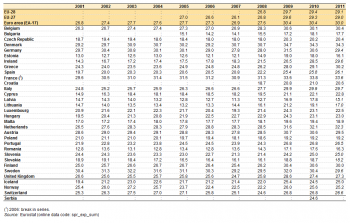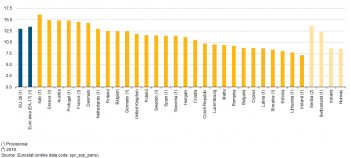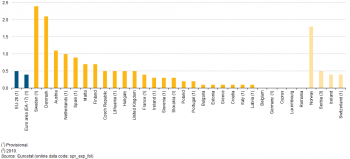Archive:Social protection statistics
- Data from December 2013. Most recent data: Further Eurostat information, Main tables and Database. Planned article update: March 2015.
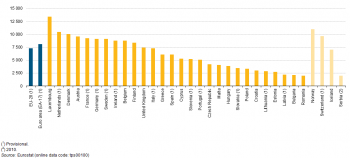
(PPS) - Source: Eurostat (tps00100)

(% of total expenditure) - Source: Eurostat (spr_exp_sum)
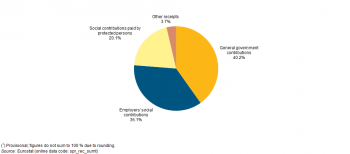
(% of total receipts) - Source: Eurostat (spr_rec_sumt)
This article analyses recent statistics on social protection in the European Union (EU). Social protection encompasses interventions from public or private bodies intended to relieve households and individuals of the burden of a defined set of risks or needs, provided that there is neither a simultaneous reciprocal nor an individual arrangement involved.
Main statistical findings
Recent developments in social protection expenditure
As the impact of the financial and economic crisis was felt across the EU-28, expenditure on social protection relative to gross domestic product (GDP) increased by 2.9 percentage points between 2008 and 2009. This increase reflected a 4.2 % increase in overall social protection expenditure (in current prices), combined with a fall in GDP (-5.8 %). In 2010 and 2011, the value of social protection expenditure increased by 3.4 % and 1.8 % respectively; current price GDP grew faster, resulting in the ratio of social protection expenditure to GDP falling by 0.3 percentage points in both 2010 and 2011. Nevertheless, in 2011, social protection expenditure relative to GDP was 29.1 % in the EU-28, and so remained 2.3 percentage points above its 2008 level (26.8 %).
Among the EU Member States, the level of social protection expenditure in relation to GDP in 2011 was highest in Denmark (34.3 %), France (33.6 %) and the Netherlands (32.3 %), while Belgium, Greece and Finland also reported ratios of 30.0 % or more. By contrast, social protection expenditure represented less than 20.0 % of GDP in Poland, Malta, Slovakia, Bulgaria, Lithuania, Romania, Estonia and Latvia (where the lowest share was registered, at 15.1 %).
In Ireland, expenditure on social protection relative to GDP in 2011 remained 8.1 percentage points higher than it had been in 2008, which was the largest increase over this period among the EU Members States. Greece, Spain, Finland, the Netherlands, Slovenia, Denmark and Cyprus all recorded increases ranging from 3.3 percentage points to 4.0 percentage points during the same period. By contrast, the increase in expenditure on social protection relative to GDP between 2008 and 2011 was 1.0 percentage point or less in Austria, Lithuania, Malta, Poland, Hungary and Sweden.
Adjustment for price level differences
The use of a purchasing power standard (PPS) facilitates a comparison of the level of social protection expenditure per inhabitant between countries, taking account of differences in price levels (see Figure 1). The highest level of expenditure on social protection per inhabitant in 2011 was registered for Luxembourg (13 416 PPS per inhabitant), followed some way behind by the Netherlands, Denmark, Austria, France, Germany and Sweden — where social protection was more than 9 000 PPS per inhabitant. By contrast, expenditure in Romania, Bulgaria and Latvia was less than 2 500 PPS per inhabitant. These disparities between countries are partly related to different levels of wealth, but may also reflect differences in social protection systems, demographic trends, unemployment rates and other social, institutional and economic factors.
Analysis of benefits and receipts
Social protection benefits made up 96.1 % of the EU-28’s social protection expenditure in 2011; the remaining 3.9 % covered administration costs and other expenditure (see Figure 2). Old age and sickness/healthcare benefits together accounted for 66.5 % of total social protection expenditure while benefits related to family/children, disability, unemployment and survivors ranged between 5.4 % and 7.7 % each; housing and social exclusion benefits not elsewhere classified accounted for the remaining 2.0 % and 1.5 % respectively.
Expenditure on pensions across the EU-28 was equivalent to 13.0 % of GDP in 2011, ranging from a high of 16.1 % in Italy to a low of just over 7.0 % in Ireland (see Figure 3). Expenditure on care for the elderly in the EU-28 accounted for 0.5 % of GDP in 2011, although Sweden reported a rate that was nearly five times as high as the average; expenditure on the elderly was less than 0.1 % of GDP in Belgium, Germany, Cyprus, Luxembourg and Romania (see Figure 4). Expenditure on care for the elderly cover care allowance, accommodation, and assistance in carrying out daily tasks.
Average (median) pension levels of 65 to 74 year-olds across the EU-28 were generally lower than average earnings for those aged 50 to 59 in 2012 (see Figure 5). This was particularly the case in Croatia, Cyprus, Denmark, Bulgaria and Ireland, where pensions represented between 36 % and 43 % of the average earnings among those aged 50 to 59. This ratio, known as the aggregate replacement ratio, was highest in Luxembourg, Romania, France and Austria (2011), where it was at least 60 %. Relatively low aggregate replacement ratios may reflect low coverage and/or low income replacement from pension schemes within current pension systems, as well as incomplete careers or an under-declaration of earnings.
An analysis of social protection receipts across the EU-28 in 2011 shows that the majority of receipts could be attributed to general government contributions (40.2 %) and employers’ social contributions (36.1 %), while around one fifth (20.1 %) of social protection receipts in the EU-28 were social contributions paid by protected persons (see Figure 6).
Data sources and availability
Data on social protection expenditure and receipts are drawn up according to the European system of integrated social protection statistics (ESSPROS) methodology; this system has been designed to allow a comparison of social protection flows between EU Member States.
In April 2007, a legal basis was established for the provision of ESSPROS with the delivery of data to start from reference year 2006, as provided by the European Parliament and Regulation 458/2007; this was later supplemented by two European Commission implementing Regulations: Regulation 1322/2007 and Regulation 10/2008.
Expenditure on social protection includes: social benefits, administration costs (which represent the costs charged to the scheme for its management and administration) and other expenditure (which consists of miscellaneous expenditure by social protection schemes, principally, payment of property income).
Social protection benefits are direct transfers, in cash or in kind, by social protection schemes to households and individuals; the purpose of the transfers is to relieve the recipients of the burden of one or more of the defined risks or needs. Social benefits are paid to households by social security funds, other government units, non-profit institutions serving households (NPISHs), employers administering unfunded social insurance schemes, insurance enterprises, or other institutional units administering privately funded social insurance schemes. Social benefits are recorded without deduction of taxes or other compulsory levies payable by recipients.
Social protection benefits are classified according to eight social protection functions (which represent a set of risks or needs):
- sickness/healthcare benefits — including paid sick leave, medical care and the provision of pharmaceutical products;
- disability benefits — including disability pensions and the provision of goods and services (other than medical care) to the disabled;
- old age benefits — including old age pensions and the provision of goods and services (other than medical care) to the elderly;
- survivors’ benefits — including income maintenance and support in connection with the death of a family member, such as a survivors’ pensions;
- family/children benefits — including support (except healthcare) in connection with the costs of pregnancy, childbirth, childbearing and caring for other family members;
- unemployment benefits — including vocational training financed by public agencies;
- housing benefits — including interventions by public authorities to help households meet the cost of housing;
- social exclusion benefits not elsewhere classified — including income support, rehabilitation of alcohol and drug abusers and other miscellaneous benefits (except healthcare).
The pensions aggregate comprises part of periodic cash benefits under the disability, old age, survivors and unemployment functions. It is defined as the sum of the following social benefits: disability pensions, early-retirement benefits due to reduced capacity to work, old age pensions, anticipated old age pensions, partial pensions, survivors’ pensions, and early-retirement benefits for labour market reasons.
The aggregate replacement ratio measures the difference between gross retirement benefits and gross earnings. It is defined as the median individual gross pension of those aged 65 to 74 relative to median individual gross earnings of those aged 50 to 59, excluding other social benefits; it is expressed in percentage terms; these data are not part of the European system of integrated social protection statistics and are collected as part of the EU’s statistics on income and living conditions (EU-SILC).
Schemes responsible for providing social protection are financed in different ways. Social protection receipts comprise social security contributions paid by employers and protected persons, contributions by general government, and other receipts from a variety of sources (for example, interest, dividends, rent and claims against third parties). Social contributions by employers are all costs incurred by employers to secure entitlement to social benefits for their employees, former employees and their dependants; they can be paid by resident or non-resident employers. They include all payments by employers to social protection institutions (actual contributions) and social benefits paid directly by employers to employees (imputed contributions). Social contributions made by protected persons comprise contributions paid by employees, by the self-employed and by pensioners and other persons.
Context
Social protection systems are generally well-developed in the EU: they are designed to protect people (to some degree) against the risks and needs associated with unemployment, parental responsibilities, sickness/healthcare and invalidity, the loss of a spouse or parent, old age, housing and social exclusion (not elsewhere classified).
Pension systems can play a role in allowing beneficiaries to maintain living standards they enjoyed in the later years of their working lives. However, as Europe’s population is becoming progressively older, the main challenge social protection systems are going to face is related to their financing, as the proportion of older persons grows while the number of persons of working age decreases.
The main policy framework in this domain concerns the open method of coordination for social protection and social inclusion, which aims to promote social cohesion and equality, through adequate, accessible and financially sustainable social protection systems and social inclusion policies. A Communication from the European Commission titled ‘Regulation 706/2005 Working together, working better: a new framework for the open coordination of social protection and inclusion policies in the European Union’ (COM(2005) 706 final) outlines the objectives, which include:
- making a decisive impact on the eradication of poverty and social exclusion;
- providing adequate and sustainable pensions;
- ensuring accessible, high-quality and sustainable healthcare and long-term care.
The organisation and financing of social protection systems is the responsibility of each of the EU Member States. The model used in each Member State is therefore somewhat different, while the EU plays a coordinating role to ensure that people who move across borders continue to receive adequate protection. The EU seeks to promote actions among the Member States to combat poverty and social exclusion, and to reform social protection systems on the basis of policy exchanges and mutual learning. This policy is known as the social protection and social inclusion process — it underpins the Europe 2020 strategy and will play an important role as the EU seeks to become a smart, sustainable and inclusive economy.
See also
- General government expenditure on social protection and health
- Social protection statistics - main indicators
- Social protection statistics - social benefits by function
- Social protection statistics - background
Further Eurostat information
Publications
- European Social Statistics - Social protection Expenditure and receipts - Data 1997-2005
- In 2006, gross expenditure on social protection accounted for 26.9% of GDP in the EU-27 - Statistics in focus 40/2009
- In 2008 gross expenditure on social protection in EU 27 accounted for 26.4 % of GDP - Statistics in focus 17/2011
- In 2009 a 6.5 % rise in per capita social protection expenditure matched a 6.1 % drop in EU-27 GDP - Statistics in focus 14/2012
Main tables
- Total expenditure on social protection (tps00098)
- Total expenditure on social protection per head of population. ECU/EUR (tps00099)
- Expenditure on social protection per inhabitant (tps00100)
- Total expenditure on social protection by type (tps00101)
- Total expenditure on social benefits (tps00102)
- Total expenditure on administration costs (tps00104)
- Other expenditure on social protection (tps00105)
- Social benefits by function (tps00106)
- Social benefits per head of population by function (tps00107)
- Expenditure on pensions (tps00103)
- Expenditure on care for elderly (tsdde530)
- Social protection receipts by type (tps00108)
Database
- Social protection (spr), see:
- Social protection expenditure (spr_expend)
- Expenditure: main results (spr_exp_sum)
- Pensions (spr_exp_pens)
- Expenditure - Tables by functions, aggregated benefits and grouped schemes, in currency (spr_exp_cur)
- Tables by functions, aggregated benefits and grouped schemes - in MIO of national currency (spr_exp_nac)
- Tables by functions, aggregated benefits and grouped schemes - million EUR (spr_exp_eur)
- Tables by functions, aggregated benefits and grouped schemes - in MIO of PPS (spr_exp_pps)
- Tables by functions, aggregated benefits and grouped schemes - in PPS per head (spr_exp_ppsh)
- Tables by functions, aggregated benefits and grouped schemes - in % of the GDP (spr_exp_gdp)
- Expenditure - Tables by benefits, by function (spr_exp_func)
- Tables by benefits - sickness/health care function (spr_exp_fsi)
- Tables by benefits - disability function (spr_exp_fdi)
- Tables by benefits - old age function (spr_exp_fol)
- Tables by benefits - survivors function (spr_exp_fsu)
- Tables by benefits - family/children function (spr_exp_ffa)
- Tables by benefits - unemployment function (spr_exp_fun)
- Tables by benefits - housing function (spr_exp_fho)
- Tables by benefits - social exclusion n.e.c. function (spr_exp_fex)
- Tables by benefits - all functions (spr_exp_fto)
- Social protection receipts (spr_receipts)
- Receipts by type (spr_rec_sumt)
- Receipts by sector of origin (spr_rec_sums)
- Receipts - Tables by sector of origin and type, in MIO of national currency (including 'euro fixed' series for euro area countries) (spr_rec_nac)
- Receipts - Tables by sector of origin and type, million EUR (spr_rec_eur)
- Receipts - Tables by sector of origin and type, in % of the GDP (spr_rec_gdp)
- Pensions beneficiaries (spr_pension)
- Pensions beneficiaries at 31st December (spr_pns_ben)
Dedicated section
Methodology / Metadata
Metadata
- Social protection (ESMS metadata file — spr_esms)
Methodology manual
Source data for tables and figures (MS Excel)
Other information
- Regulation 10/2008 of 8 January 2008 implementing Regulation 458/2007 as regards the definitions, detailed classifications and updating of the rules for dissemination for the ESSPROS core system and the module on pension beneficiaries
- Regulation 458/2007 of 25 April 2007 on the European system of integrated social protection statistics (ESSPROS)
- Regulation 1322/2007 of 12 November 2007 implementing Regulation 458/2007 as regards the appropriate formats for transmission, results to be transmitted and criteria for measuring quality for the ESSPROS core system and the module on pension beneficiaries
- Regulation 110/2011 of 8 February 2011 implementing Regulation (EC) No 458/2007 of the European Parliament and of the Council on the European system of integrated social protection statistics (ESSPROS) as regards the appropriate formats for the transmission of data, the results to be transmitted and the criteria for measuring quality for the ESSPROS module on net social protection benefits
- Regulation 263/2011 of 17 March 2011 implementing Regulation (EC) No 458/2007 of the European Parliament and of the Council on the European system of integrated social protection statistics (ESSPROS) as regards the launch of full data collection for the ESSPROS module on net social protection benefits.
